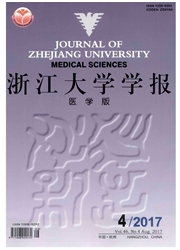

 中文摘要:
中文摘要:
目的:构建RCAS1的重组质粒、表达GST—RCAS1融合蛋白并进行纯化和生物学活性鉴定。方法:从MCF-7细胞提取总RNA,通过RT—PCR得到RCAS1的扩增产物,纯化后用EcoRⅠ和BarnHⅠ双酶切。选择pGEX-2T作为载体,用EcoRⅠ和BarnHⅠ双酶切后与上述酶切后DNA连接,转化感受态JM109大肠杆菌,挑单个菌落提取质粒进行双酶切和测序鉴定。选择测序正确的质粒重新转化BL21大肠杆菌,用终浓度0.1mmol/L的IPTG诱导表达GST—RCAS1蛋白,用GST亲和层析纯化并通过SDS—PAGE电泳和Western印迹试验证实。利用特异性抗RCAS1多抗(N-18和C-20)鉴定所表达的融合蛋白,通过流式细胞仪检测GST—RCAS1融合蛋白诱导活化T细胞凋亡的作用。结果:通过RT—PCR得到大小为642bp的产物,重组质粒通过双酶切和测序鉴定正确。通过IPTG诱导在BL21大肠杆菌中表达并纯化得到GST—RCAS1蛋白,通过SDS—PAGE电泳鉴定分子量为52kMr,与预测一致,并由Western印迹试验证明为GST融合蛋白。该融合蛋白能被特异性抗RCAS1(N-18和C-20)多抗识别。GST—RCAS1对诱导活化的T细胞凋亡有一定的作用。结论:成功构建RCAS1的重组质粒,并表达GST—RCAS1融合蛋白,对其生物学活性作了初步研究。
 英文摘要:
英文摘要:
Objective: To construct the recombinant plasmid of RCASI,to express and purify its fusion protein GST-RCAS1, and to investigate its biological function. Methods: RCAS1 encoding gene was amplified by RT-PCR from total RNA extract of MCF-7 cells and was ligated with expression plasmid vector pGEX-2T by T4 DNA ligase after digested by the restricted endonucleases BamH I and EcoR I. Then the ligated products were inserted into competence JM109 E. Coli and the positive recombinants were identified by restriction endonuclease digestion assay and DNA sequencing. The GST-RCAS1 fusion protein expression was induced by IPTG in BL21 E. Coli and was purified with GST column and identified by SDS-PAGE and Western blotting with anti-GST monoclonal antibody, anti-RCAS1 (N-18) and anti-RCAS1 (C-20) polyclonal antibody. The apoptosis of activated T cells induced by GST-RCAS1 fusion protein was detected by flow cytometry with Annexin V and propidium iodide (PI) staining. Results: A 642 bp product was cloned by RT-PCR and the recombinant plasmid was constructed successfully. The GST-RCAS1 fusion protein was recognized by GST monoclonal antibody and RCAS1 (N-18 and C-20) polyclonal antibody. FACS analysis showed that GST-RCAS1 fusion protein induced apoptosis in activated T cells. Conclusion: The recombinant plasmid of RCAS1 has been successfully constructed and the GST-RCAS1 fusion protein expressed and purified. The apoptosis inducing effect of GST-RCAS1 fusion protein on activated T cells is demonstrated.
 同期刊论文项目
同期刊论文项目
 同项目期刊论文
同项目期刊论文
 期刊信息
期刊信息
